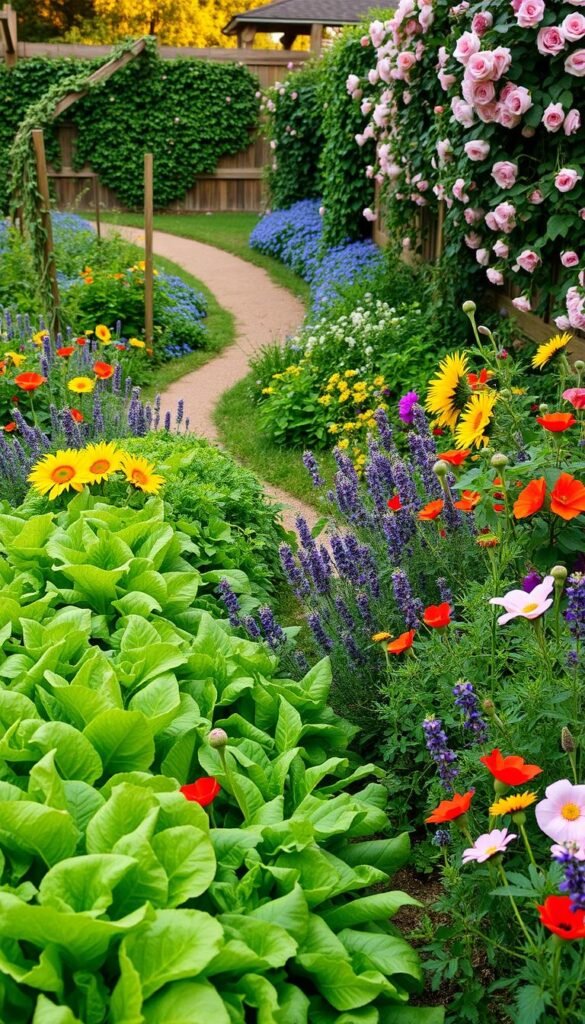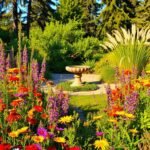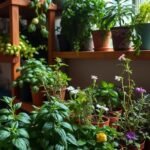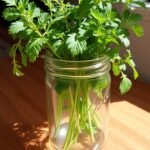What if your food-growing space could dazzle visitors and feed your family? Many assume edible plots belong hidden in backyards, but that’s like keeping a masterpiece painting in the attic. With smart design, your garden can become a vibrant showpiece bursting with color and flavor.
Imagine plucking ripe tomatoes beside sunflowers tall enough to shade your lettuce. Picture pollinators dancing between zucchini blossoms and marigolds. This approach blends practicality with beauty – no more choosing between vegetables and curb appeal.
You’ll discover how strategic flower placement creates living bouquets that boost crop health. Bright blooms attract bees while repelling pests naturally. The result? A space that’s equal parts productive and picturesque, transforming your property’s least exciting corner into its star attraction.
This guide reveals how to balance form and function without sacrificing harvests. Learn which plants partner best, design tricks for visual impact, and maintenance tips to keep your dual-purpose paradise thriving all season. Ready to make neighbors do a double-take?
Plan Your Layout: Creating Space for Both Flowers and Vegetables
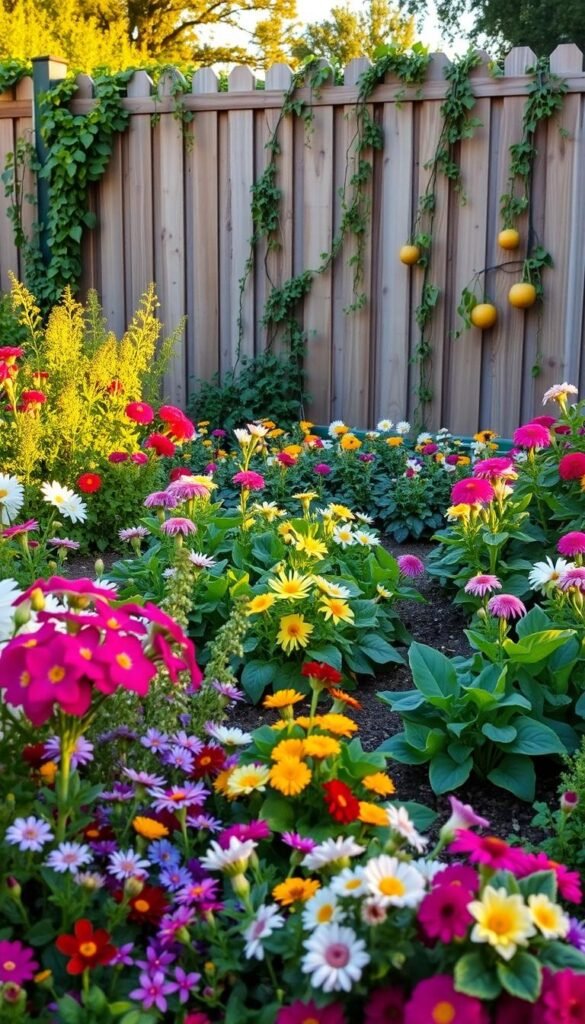
Ever feel like arranging plants is solving a delicious puzzle? Smart space management turns your plot into a living mosaic where edibles and ornamentals enhance each other. Start by sketching zones for leafy greens and vibrant blooms, using pathways as natural dividers.
Design Considerations and Space Allocation
Think like a chess player planning three moves ahead. Tuck compact nasturtiums at bed corners where they won’t block sunlight. Leave 18-inch walkways between raised beds for easy harvesting. Here’s a pro tip: Tall sunflowers make perfect backdrops for shorter pepper plants.
| Plant Type | Ideal Spacing | Best Placement |
|---|---|---|
| Tomatoes | 24-36″ apart | Center of beds |
| Zinnias | 12-18″ apart | Bed ends |
| Leafy greens | 6-8″ apart | Front edges |
| Marigolds | 8-10″ apart | Between veggies |
Optimizing Raised Beds and Garden Beds
Raised beds give you height advantage – literally. Build tiered structures to showcase trailing petunias above carrot rows. Use cedar boards or stone borders to frame your vegetable garden areas while keeping soil contained. Pro tip: Leave extra room at bed edges for future vining flowers like morning glories.
Rotate crops annually to refresh your space, and remember: not every bed needs floral accents. Three well-placed clusters of cosmos create rhythm without overwhelming your harvest potential.
Selecting the Perfect Flower Varieties for Your Garden
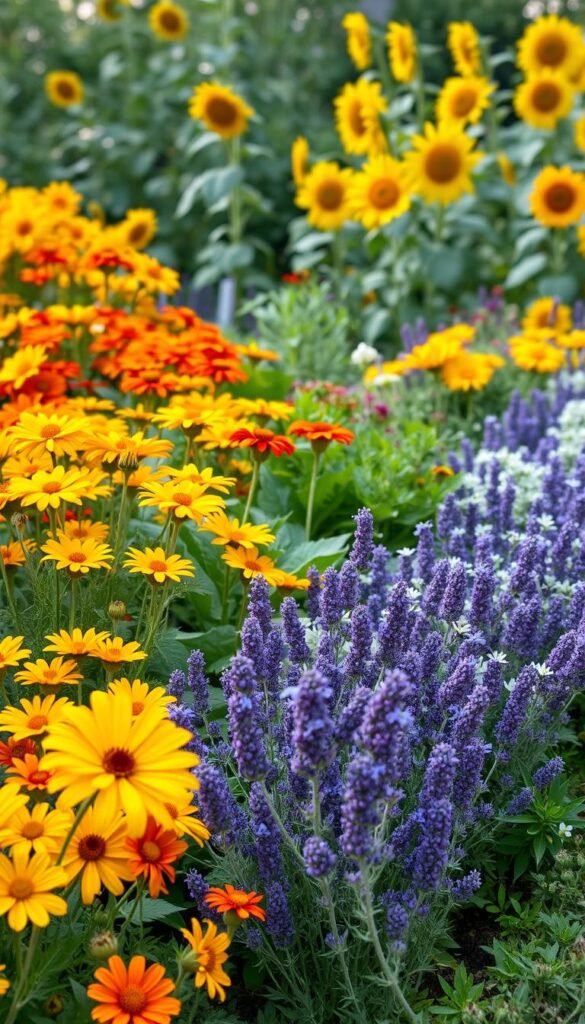
Choosing bloom companions for edible plots requires strategy. The right mix creates a living tapestry that feeds both pollinators and your family. Let’s explore options that marry visual punch with practical benefits.
Annuals vs. Perennials: Seasonal Showstoppers
Annual flowers work like clockwork with crops. Zinnias and marigolds bloom nonstop from spring frost to fall’s first chill, matching your tomatoes’ timeline. For early color, tuck daffodil bulbs into bed corners during autumn planting – they’ll erupt as peas sprout.
Consider these performers:
- Benary’s Giant zinnias (disease-resistant)
- Climbing nasturtiums (edible blooms)
- Globe amaranth (drought-tolerant)
Vertical Accents and Bouquet Boosters
Vining varieties turn fences into floral curtains. Morning glories scale trellises while shading heat-sensitive lettuces. For cut flower magic, grow Strawberry Fields globe amaranth – their raspberry-colored blooms last weeks in vases.
Black-eyed Susans add golden pops between kale rows. Their sturdy stems withstand summer storms, and bees adore them. Remember: Three strategic clusters create rhythm without crowding your plants.
Flower and Vegetable Garden Combined: Beautifying Your Yard with Dual Purpose
Transform your edible plot into a living masterpiece that feeds both body and soul. Strategic placement turns functional rows into eye-catching displays where vegetables share soil with nature’s decorators. Tuck vibrant pansies between broccoli plants or let purple basil double as ornamental edging.
Smart pairings create mutual benefits. Sunflowers lift their sunny faces above potato mounds, shading tender roots while attracting aphid-eating ladybugs. Try these winning combinations:
| Edible Crop | Floral Partner | Benefits |
|---|---|---|
| Tomatoes | Marigolds | Nematode control |
| Cucumbers | Nasturtiums | Trap crop for beetles |
| Kale | Snapdragons | Vertical interest |
| Carrots | Alyssum | Groundcover & hoverflies |
This approach does more than please the eye. Blooming allies bring in pollinators that boost yields by up to 30%. Pro tip: Use red celosia near beans – their spiky plumes mirror pole beans’ vertical growth while confusing pest moths.
Your garden becomes a destination rather than just a food source. Curved pathways lined with chamomile invite exploration, while scarlet runner beans on obelisks create living sculptures. The result? A space that nourishes your family and neighborhood curiosity in equal measure.
Incorporating Raised Beds for Maximum Impact
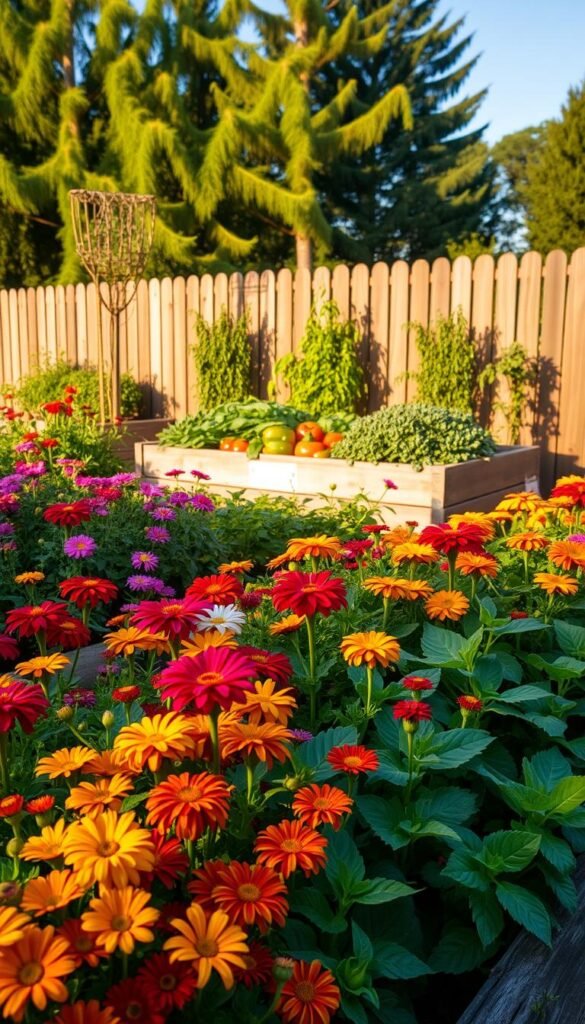
Raised beds revolutionize how you merge beauty and bounty in your outdoor space. These structured planters keep roots contained while letting creativity run wild. Their vertical design creates natural focal points that showcase trailing blooms alongside crisp lettuces.
Building Functional and Attractive Raised Beds
Start with a step-by-step raised bed construction guide for foolproof results. Cedar or composite boards resist rot while complementing your landscape. Keep walls 12-18″ tall for easy access and dramatic plant layering.
Try these smart configurations:
| Material | Best For | Plant Pairing |
|---|---|---|
| Cedar | Longevity | Dahlias + peppers |
| Metal | Modern looks | Cosmos + kale |
| Stone | Natural appeal | Petunias + herbs |
Elevated beds simplify soil management. Fill them with 60% topsoil, 30% compost, and 10% sand for drainage. This mix supports hungry tomatoes and delicate alyssum equally well.
Arrange multiple raised beds in staggered rows for visual rhythm. Leave 24″ between units for kneeling room. Edge pathways with creeping thyme – its purple flowers soften hard lines while deterring slugs.
Pro tip: Dedicate one bed entirely to flowers if you love fresh bouquets. Zinnias and snapdragons thrive in contained space, letting you test floral arrangements without overwhelming edible crops.
Seasonal Planting: From Early Spring Bulbs to Summer Blooms
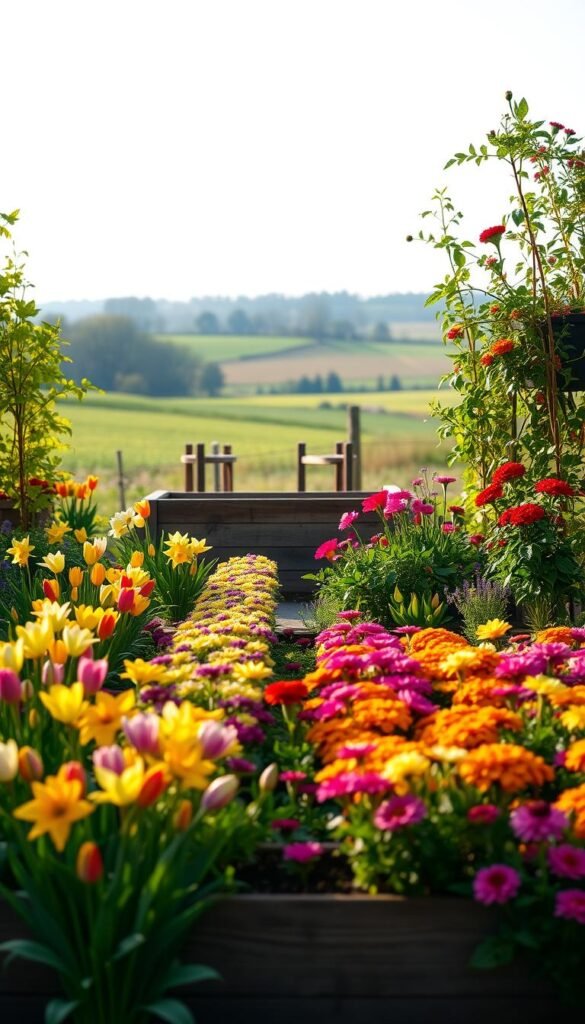
Timing is the secret ingredient that transforms ordinary plots into year-round spectacles. By syncing bloom cycles with harvest schedules, you create living theater where petals and produce share the stage.
Timing Your Planting for Continuous Color
Strategic planning begins when autumn leaves fall. Tuck daffodil bulbs beside garlic cloves in October – they’ll erupt as winter loosens its grip. These early risers brighten beds while spring greens stretch their first leaves.
Follow this rhythm:
- Sow cold-hardy pansy seeds as maple trees bud
- Start zinnia plants indoors 6 weeks before last frost
- Transplant marigolds when soil hits 70°F
Peak floral displays in July pair perfectly with young cucumbers. By August, sunflowers tower over ripening tomatoes, creating layered interest. Don’t forget late performers like asters – their purple bursts mask fading bean plants after Labor Day.
Smart season extensions keep the show running. Sow quick-growing calendula every 3 weeks from May through September. Their orange faces will greet you until time for pumpkin carving arrives.
Attracting Beneficial Insects and Pollinators
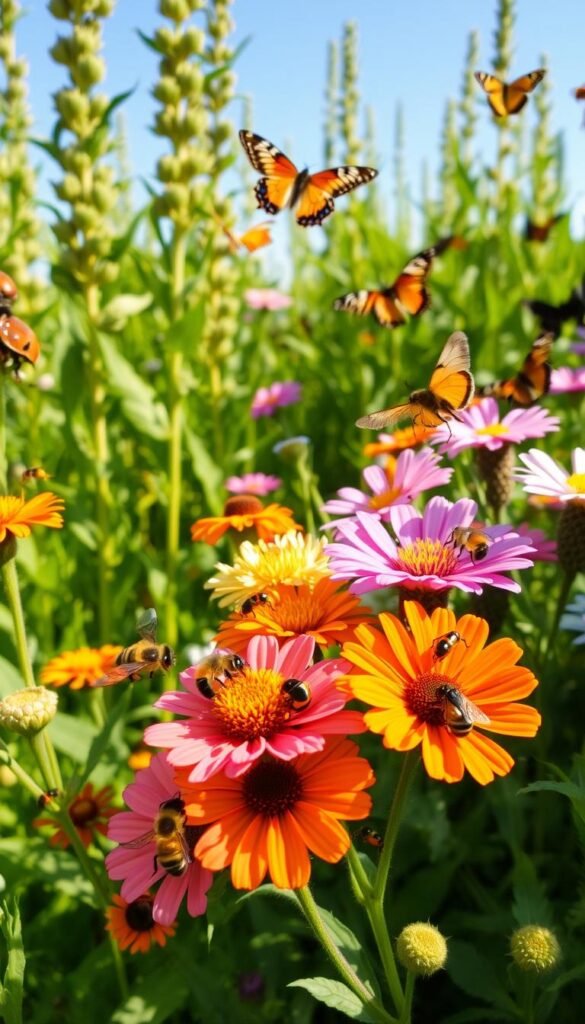
Your edible plot becomes a bustling ecosystem when blooms work overtime. Strategic placement of vibrant petals creates nature’s security team – beneficial insects patrol your crops while adding lively movement to your space.
Using Colorful Blooms to Invite Bees, Butterflies, and More
Bright petals act as landing pads for nature’s helpers. Purple-top verbena becomes butterfly central from midsummer onward, its airy stems allowing easy nectar access. For hummingbird action, plant Lady in Red salvia – its tubular scarlet blooms fuel these aerial acrobats through frost.
Consider these powerhouse pairings:
| Plant | Attracts | Pest Control |
|---|---|---|
| Dill | Parasitic wasps | Eliminates aphids |
| Sunflowers | Lady beetles | Devours mites |
| Calendula | Hoverflies | Targets thrips |
| Yarrow | Lacewings | Controls mealybugs |
Create pollinator-friendly spaces by grouping similar colors. Bees favor blue and yellow hues, while butterflies seek red and purple. Plant in clusters of 3-5 specimens for maximum visibility.
Rotate bloom times to maintain insect interest. Early spring alyssum supports emerging bees, while autumn sedum feeds migrating monarchs. This continuous buffet keeps helpful insects like soldier beetles patrolling your peppers and eggplants all season.
Companion Planting Tips: Flowers and Veggies That Thrive Together
Nature’s matchmakers work overtime in smart gardens. Strategic pairings between blooms and crops create living alliances where both partners flourish. This approach turns your plot into a self-sustaining ecosystem bursting with color and crunch.
Enhancing Growth and Repelling Pests Naturally
French marigolds are the superheroes of companion planting. Their roots release pyrethrum – nature’s pest repellent – that deters nematodes attacking tomato roots. Plant these golden guardians beside peppers or cucumbers to shield them from squash bugs and beetles.
Try these powerhouse partnerships:
| Edible Crop | Floral Ally | Key Benefit |
|---|---|---|
| Tomatoes | Basil + Marigolds | Boosts flavor, repels worms |
| Beans | Nasturtiums | Traps aphids away from pods |
| Cabbage | Calendula | Deters white butterflies |
Time your plantings for maximum impact. Sow marigold seeds two weeks before transplanting tomatoes. This gives their pest-fighting chemicals time to build up in the soil. For container gardens, pair compact zinnias with dwarf basil – they’ll share nutrients while saving space.
Blooms do more than protect. Borage adds trace minerals to soil as it grows, benefiting nearby strawberries. Sunflowers act as living trellises for pole beans, their stalks supporting vines while attracting aphid-eating birds. The result? Less work for you, more bounty from your plot.
Maximizing Vertical Space With Trellises and Vining Flowers
Elevate your growing game by looking up – literally. Vertical structures transform bare walls and fences into lush green tapestries bursting with edible and ornamental delights. This approach lets you triple production without expanding your plot’s footprint.
DIY Cattle Panel Trellis Ideas
Cattle panels offer unbeatable durability for climbing plants. Bend 16-foot panels into arches between raised beds for instant drama. Secure them to T-posts with zip ties – no welding required. These grids support heavy squash vines better than flimsy store-bought options.
| Material | Cost | Best For | Plant Pairing |
|---|---|---|---|
| Cedar posts | $$ | Permanent setups | Gourds |
| Metal T-posts | $ | Temporary designs | Cucumbers |
| PVC pipes | $$ | Lightweight blooms | Nasturtiums |
Growing Climbing Varieties for Extra Impact
Moonlight Climbing Nasturtiums steal the show with buttery yellow blooms that spiral upward all summer. Pair them with scarlet runner beans for a fiery contrast. Train vines early – gently weave tendrils through trellis openings every three days.
| Variety | Growth Rate | Special Feature |
|---|---|---|
| Climbing Phoenix | Moderate | Peach-colored petals |
| Morning Glory | Fast | Daily blue blooms |
| Sweet Pea | Rapid | Fragrant stems |
Space plants 12″ apart at the trellis base. Use soft twine to guide stubborn stems. By midsummer, your vertical displays will buzz with pollinators while hiding compost bins or AC units in style.
Creative Design Elements: Borders, Pathways, and Focal Points
Borders and pathways aren’t just decorative—they’re your garden’s backbone. Thoughtful design elements turn functional plots into immersive spaces where beauty and productivity hold equal sway.
Integrating Perennial Borders and Edging
Frame your edible areas with perennial borders that work year-round. Early-blooming peonies and late-season sedum extend visual interest when vegetables fade. These living edges create natural screens, softening transitions between your flower garden and practical plots.
Curved pathways lined with crushed stone guide exploration while preventing soil compaction. Alternate stepping stones with creeping thyme for textural contrast. This approach maintains clean divisions between zones without harsh barriers.
Anchor your design with focal points that command attention. A rustic obelisk draped in scarlet runner beans becomes a vertical masterpiece. Cluster potted lavender near seating areas—their fragrance enhances relaxation while repelling mosquitoes.
Strategic color placement amplifies impact. Position golden coreopsis where afternoon light sets their petals glowing. This creates depth and movement, making every stroll through your garden feel like discovering hidden treasure.
